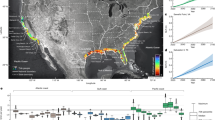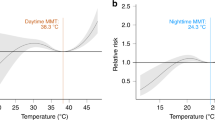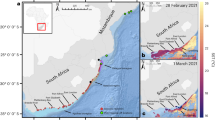Abstract
The sprawl of marine construction is one of the most extreme human modifications to global seascapes. Nevertheless, its global extent remains largely unquantified compared to that on land. We synthesized disparate information from a diversity of sources to provide a global assessment of the extent of existing and projected marine construction and its effects on the seascape. Here we estimated that the physical footprint of built structures was at least 32,000 km2 worldwide as of 2018, and is expected to cover 39,400 km2 by 2028. The area of seascape modified around structures was 1.0–3.4 × 106 km2 in 2018 and was projected to increase by 50–70% for power and aquaculture infrastructure, cables and tunnels by 2028. In 2018, marine construction affected 1.5% (0.7–2.4%) of global Exclusive Economic Zones, comparable to the global extent of urban land estimated at 0.02–1.7%. This study provides a critical baseline for tracking future marine human development.
This is a preview of subscription content, access via your institution
Access options
Access Nature and 54 other Nature Portfolio journals
Get Nature+, our best-value online-access subscription
$29.99 / 30 days
cancel any time
Subscribe to this journal
Receive 12 digital issues and online access to articles
$119.00 per year
only $9.92 per issue
Buy this article
- Purchase on Springer Link
- Instant access to full article PDF
Prices may be subject to local taxes which are calculated during checkout



Similar content being viewed by others
Data availability
The marine construction inventory produced by the authors and original data sources that support the findings of this study are available at http://doi.org/10.5281/zenodo.3898027. An inventory of offshore wind, tidal and wave farms can be found at 4Coffshore.com. Source data are provided with this paper.
Code availability
No custom computer code or algorithm was used to generate results.
References
McKinney, M. L. Effects of urbanization on species richness: a review of plants and animals. Urban Ecosyst. 11, 161–176 (2008).
Elvidge, C. D. et al. Global distribution and density of constructed impervious surfaces. Sensors 7, 1962–1979 (2007).
Firth, L. B. et al. Ocean sprawl: challenges and opportunities for biodiversity management in a changing world. Oceanogr. Mar. Biol. Annu. Rev. 54, 189–262 (2016).
Gittman, R. K., Scyphers, S. B., Smith, C. S., Neylan, I. P. & Grabowski, J. H. Ecological consequences of shoreline hardening: a meta-analysis. BioScience 66, 763–773 (2016).
The Ocean Economy in 2030 (OECD Publishing, 2016).
Ali, A., Hassan, R., Bidin, R. & Theparoonrat, Y. Enhancing Management of Fishery Resources through Intensified Efforts in Habitat Conservation and Rehabilitation (Secretariat, Southeast Asian Fisheries Development Center, 2011).
Santos, M. N. & Monteiro, C. C. The Olhão artificial reef system (south Portugal): fish assemblages and fishing yield. Fish. Res. 30, 33–41 (1997).
Murray, N. J. et al. The global distribution and trajectory of tidal flats. Nature 565, 222–225 (2019).
Jones, K. R. et al. The location and protection status of earth’s diminishing marine wilderness. Curr. Biol. 28, 2506–2512. (2018).
Mayer-Pinto, M., Dafforn, K. A. & Johnston, E. L. A decision framework for coastal infrastructure to optimize biotic resistance and resilience in a changing climate. BioScience 69, 833–843 (2019).
Cao, L. et al. Environmental impact of aquaculture and countermeasures to aquaculture pollution in China. Environ. Sci. Pollut. Res. Int. 14, 452–462 (2007).
Hobbs, R. J. et al. Novel ecosystems: theoretical and management aspects of the new ecological world order. Glob. Ecol. Biogeogr. 15, 1–7 (2006).
Merchant, N. D., Pirotta, E., Barton, T. R. & Thompson, P. M. Monitoring ship noise to assess the impact of coastal developments on marine mammals. Mar. Pollut. Bull. 78, 85–95 (2014).
Heery, E. et al. Identifying the consequences of ocean sprawl for sedimentary habitats. J. Exp. Mar. Biol. Ecol. 492, 31–48 (2017).
Davis, N., VanBlaricom, G. R. & Dayton, P. K. Man-made structures on marine sediments: effects on adjacent benthic communities. Mar. Biol. 70, 295–303 (1982).
Hawkins, S. J. et al. Consequences of climate-driven biodiversity changes for ecosystem functioning of North European rocky shores. Mar. Ecol. Prog. Ser. 396, 245–259 (2009).
Bishop, M. J. et al. Effects of ocean sprawl on ecological connectivity: impacts and solutions. J. Exp. Mar. Biol. Ecol. 492, 7–30 (2017).
Airoldi, L., Turon, X., Perkol-Finkel, S. & Rius, M. Corridors for aliens but not for natives: effects of marine urban sprawl at a regional scale. Divers. Distrib. 21, 755–768 (2015).
Halpern, B. S. et al. A global map of human impact on marine ecosystems. Science 319, 948–952 (2008).
Halpern, B. S. et al. Spatial and temporal changes in cumulative human impacts on the world’s ocean. Nat. Commun. 6, 7615 (2015).
Halpern, B. S. et al. An index to assess the health and benefits of the global ocean. Nature 488, 615–620 (2012).
Ban, N. C., Alidina, H. M. & Ardron, J. A. Cumulative impact mapping: advances, relevance and limitations to marine management and conservation, using Canada’s Pacific waters as a case study. Mar. Policy 34, 876–886 (2010).
Kapetsky, J. M., Aguilar-Manjarrez, J. & Jenness, J. A. FAO Fisheries and Aquaculture Technical Paper No. 549 (FAO, 2013).
Trujillo, P., Piroddi, C. & Jacquet, J. Fish farms at sea: the ground truth from google earth. PLoS ONE 7, e30546 (2012).
Kaschner, K. et al. AquaMaps: Predicted Range Maps for Aquatic Species (Secretariat of the Pacific Regional Environment Programme, 2018); https://go.nature.com/2FhXpzU
Stuart-Smith, R. D. et al. Integrating abundance and functional traits reveals new global hotspots of fish diversity. Nature 501, 539–542 (2013).
Neumann, B., Vafeidis, A. T., Zimmermann, J. & Nicholls, R. J. Future coastal population growth and exposure to sea-level rise and coastal flooding—a global assessment. PLoS ONE 10, e0118571 (2015).
Corporate Partnership Board Capacity to Grow: Transport Infrastructure Needs for Future Trade Growth (International Transport Forum, OECD, 2016).
NSW Boat Ownership and Storage: Growth Forecasts to 2026 (New South Wales Government, 2010).
Gibson, J. A., Pratt, W. B. & Holcomb, J. C. in Report to the California Department of Boating and Waterways 6-1–6-17 (Department of Boating and Waterways, 2002).
Yang, D., Liu, Q., Jiang, L., Zhang, W. & Chu, W. in Maritime Business and Economics: Asian Perspectives (ed. Duru, O.) 99–117 (Routledge, 2019).
Artificial Reefs (NSW Department of Primary Industries, accessed May 2020); https://go.nature.com/2DErppg
Rigs to Reefs (Bureau of Safety and Environmental Enforcement, accessed June 2019); https://go.nature.com/3fKYxsg
Jørgensen, D. OSPAR’s exclusion of rigs-to-reefs in the North Sea. Ocean Coast. Manag. 58, 57–61 (2012).
Eurosion Living with Coastal Erosion in Europe: Sediment and Space for Sustainability: PART II – Maps and Statistics (Directorate General Environment, European Commission, 2004).
Gittman, R. K. et al. Engineering away our natural defenses: an analysis of shoreline hardening in the US. Front. Ecol. Environ. 13, 301–307 (2015).
Schneider, A., Friedl, M. A. & Potere, D. Mapping global urban areas using MODIS 500-m data: new methods and datasets based on ‘urban ecoregions’. Remote Sens. Environ. 114, 1733–1746 (2010).
Bunting, P. et al. The global mangrove watch—a new 2010 global baseline of mangrove extent. Remote Sens. 10, 1669 (2018).
UNEP-WCMC & Short, F. T. Global Distribution of Seagrasses (version 6.0) (UN EWC Monitoring Centre, 2018);https://data.unep-wcmc.org/datasets/7
Kennish, M. J. Environmental threats and environmental future of estuaries. Environ. Conserv. 29, 78–107 (2002).
Duggins, D., Simenstad, C. & Estes, J. Magnification of secondary production by kelp detritus in coastal marine ecosystems. Science 245, 170–173 (1989).
Sheehan, E. V. et al. Development of epibenthic assemblages on artificial habitat associated with marine renewable infrastructure. ICES J. Mar. Sci. 77, 1178–1189 (2018).
Kamermans, P. et al. Offshore wind farms as potential locations for flat oyster (Ostrea edulis) restoration in the Dutch North Sea. Sustainability 10, 3942 (2018).
De Dominicis, M., O’Hara Murray, R. & Wolf, J. Multi-scale ocean response to a large tidal stream turbine array. Renew. Energy 114, 1160–1179 (2017).
Cohen-Shacham, E., Walters, G., Janzen, C. & Maginnis, S. Nature-based Solutions to Address Global Societal Challenges (IUCN, 2016).
Dafforn, K. A. et al. Marine urban sprawl: how can ecology inform the design of multifunctional artificial structures? Front. Ecol. Environ. 13, 82–90 (2015).
Morris, R. L. et al. Design Options, Implementation Issues and Evaluating Success of Ecologically Engineered Shorelines (Taylor & Francis, 2019).
Firth, L. B. et al. Greening of grey infrastructure should not be used as a Trojan horse to facilitate coastal development. J. Appl. Ecol. https://doi.org/10.1111/1365-2664.13683 (2020).
Lujala, P., Ketil Rod, J. & Thieme, N. Fighting over oil: introducing a new dataset. Confl. Manag. Peace Sci. 24, 239–256 (2007).
Reefs at Risk Revisited (World Resources Institute, 2011).
Inventory of Submarine Telecommunication Cables (www.submarinecablemap.com). TeleGeography www2.telegeography.com (2018).
State of the Environment 2018 (Italian Institute for Environmental Protection and Research, 2018).
The Intersect of the Exclusive Economic Zones and IHO Sea Areas, Version 3 (Flanders Marine Institute, 2008).
Offshore wind, wave and tide farms. 4C Offshore Ltd. www.4coffshore.com (2018).
Wyatt, S. et al. Detailed Appraisal of the Offshore Wind Industry in China (Carbon Trust, 2014).
Bivand, R., Keitt, T. & Rowlingson, B. rgdal: Bindings for the ‘Geospatial’ Data Abstraction Library (CRAN.R-project, 2019); https://CRAN.R-project.org/package=rgdal
South, A. rworldmap: a new R package for mapping global data. R Journal 3, 35–43 (2011).
Wickham, H. ggplot2: Elegant Graphics for Data Analysis (Springer, 2016).
OECD-FAO Agricultural Outlook 2017–2026 (OECD Publishing, 2017).
Wang, W., Liu, H., Li, Y. & Su, J. Development and management of land reclamation in China. Ocean Coast. Manag. 102, 415–425 (2014).
Reyna, J. et al. in The First Global Integrated Marine Assessment. World Ocean Assessment (eds Inniss, L. et al.) Ch. 26 (United Nations, 2016).
Murray, N. J., Clemens, R. S., Phinn, S. R., Possingham, H. P. & Fuller, R. A. Tracking the rapid loss of tidal wetlands in the Yellow Sea. Front. Ecol. Environ. 12, 267–272 (2014).
MacKinnon, J., Verkuil, Y. I. & Murray, N. Situation Analysis on East and Southeast Asian Intertidal Habitats, with Particular Reference to the Yellow Sea (including the Bohai Sea) (IUCN, 2012).
Hugo, G. Future demographic change and its interactions with migration and climate change. Glob. Environ. Change 21, S21–S33 (2011).
Sovacool, B. K. Hard and soft paths for climate change adaptation. Clim. Policy 11, 1177–1183 (2011).
Loke, L. H. L., Heery, E. C. & Todd, P. A. in World Seas: An Environmental Evaluation 2nd edn (ed. Sheppard, C.) Ch. 26 (Academic Press, 2019).
Jackson, M. D. et al. Phillipsite and Al-tobermorite mineral cements produced through low-temperature water-rock reactions in Roman marine concrete. Am. Mineral. 102, 1435–1450 (2017).
Dietz, B. Dikes, dockheads and gates: English docks and sea power in the sixteenth and seventeenth centuries. Mar. Mirror 88, 144–154 (2002).
Palmer, S. Current port trends in an historical perspective. J. Marit. Res. 1, 99–111 (1999).
Charlier, R. H., Chaineux, M. C. P. & Morcos, S. Panorama of the history of coastal protection. J. Coast. Res. 21, 79–111 (2005).
Galloway, J. A. Storm flooding, coastal defence and land use around the Thames estuary and tidal river c.1250–1450. J. Medieval Hist. 35, 171–188 (2009).
Beveridge, M. C. & Little, D. C. in Ecological Aquaculture. The Evolution of the Blue Revolution (ed. Costa-Pierce, B. A.) 3–29 (Blackwells, 2002).
D’itri, F. M. Artificial Reefs: Marine and Freshwater Applications (CRC Press, 2018).
Grosbard, A. Treadwell warf in the Summerland, California oil field: the firmest sea wells in petroleum exploration. Oil Ind. Hist. 3, 1–18 (2002).
Priest, T. Extraction not creation: the history of offshore petroleum in the gulf of Mexico. Enterp. Soc. 8, 227–267 (2007).
Breton, S.-P. & Moe, G. Status, plans and technologies for offshore wind turbines in Europe and North America. Renew. Energ. 34, 646–654 (2009).
Danel, P. Tetrapods. Coast. Eng. Proc. 1, 28 (1953).
Phillips, M. R. & Jones, A. L. Erosion and tourism infrastructure in the coastal zone: problems, consequences and management. Tour. Manag. 27, 517–524 (2006).
Chapman, M. G. & Blockley, D. J. Engineering novel habitats on urban infrastructure to increase intertidal biodiversity. Oecologia 161, 625–635 (2009).
Burcharth, H. F., Hawkins, S. J., Zanuttigh, B. & Lamberti, A. Environmental Design Guidelines for Low Crested Coastal Structures (Elsevier, 2007).
Acknowledgements
This research was supported by the Australian Research Council through a Linkage Grant (no. LP140100753) awarded to K.A.D., L.A. and E.L.J. A.B.B. was funded by a Maple Brown Foundation grant awarded to K.A.D. and R.A.C. and an Ian Potter Foundation grant to K.A.D. E.M.A.S. received funding from the World Harbour Project, The Ian Potter Foundation and The New South Wales Government Office of Science and Research. L.A. received funding through the Macquarie University FSE Visiting Researcher Fellowship Scheme. This is Sydney Institute of Marine Science (SIMS) publication no. 259.
Author information
Authors and Affiliations
Contributions
All authors contributed to the original concept of this manuscript, helped in the data-gathering effort and commented on the manuscript. A.B.B., K.A.D., M.M.-P., L.A. and E.L.J. led the implementation of the initial concept and manuscript preparation. A.B.B. led the data-gathering effort, analysed data and prepared the manuscript.
Corresponding author
Ethics declarations
Competing interests
The authors declare no competing interests.
Additional information
Publisher’s note Springer Nature remains neutral with regard to jurisdictional claims in published maps and institutional affiliations.
Extended data
Extended Data Fig. 1 Global distribution of physical footprint of marine construction as of 2018.
Data for aquaculture a, artificial reefs c, marinas d, and oil and gas pipelines e, are expressed per km2 within each Exclusive Economic Zone (grey: missing data). The location of commercial ports and their size (estimated considering physical size and traffic) were sourced from the World Resources Institute b. Oil and gas rigs f, are expressed per km2 within each offshore field. Location of each structure (blue dots) is shown for tunnels and bridges g, breakwaters h, and artificial islands i.
Supplementary information
Supplementary Information
Supplementary methods, Tables 1 and 2 and references.
Source data
Rights and permissions
About this article
Cite this article
Bugnot, A.B., Mayer-Pinto, M., Airoldi, L. et al. Current and projected global extent of marine built structures. Nat Sustain 4, 33–41 (2021). https://doi.org/10.1038/s41893-020-00595-1
Received:
Accepted:
Published:
Issue Date:
DOI: https://doi.org/10.1038/s41893-020-00595-1



